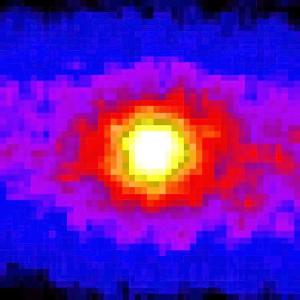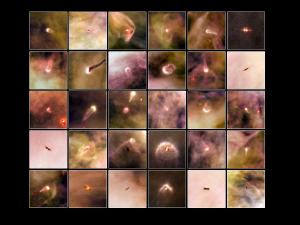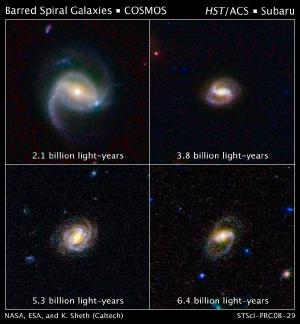Blog
Testing the
Electric Universe
25 February 2014
There’s a cosmological model that has gained popularity on the internet known as the Electric Universe. The basic claim of the Electric Universe model is that much of the astronomical phenomena observed in the universe is driven by electrical interactions rather than gravitational ones. Proponents of the model claim that the Electric Universe is a much simpler solution that solves many of the cosmic mysteries mainstream astro-scientists are unable to solve. The model is so simple that it doesn’t require any of that mathematical obfuscation found in the standard model. But astro-scientists are too set in their ways to look at the model with an open mind. We certainly can’t ignore such a revolutionary idea, so let’s put it to the test.
There are actually many variations to the Electric Universe model, but the most popular version seems to focus around the book by Thornhill and Talbot listed below.1 It is this basic model I’ll discuss here, using the references listed at the bottom of the post.2 If you want to get an overview of the model, Findlay’s ebook (available for free) is as good a reference as any.3 The basic idea of this particular model is that cosmic magnetic fields interact with interstellar plasma to drive astrophysical processes. Gravitational interactions play a negligible role in the universe. From this idea several claims and predictions are made. In particular:
- Neither dark matter nor dark energy exist. Black holes don’t exist. The big bang didn’t happen.
- Galaxies are formed by kinks in cosmic magnetic fields. They begin as electric quasars which then expand into modern galaxies.
- Stars are electrically charged masses formed within galactic plasmas. They are not heated by nuclear fusion within their core, but rather by a flow of plasma, similar to a florescent light.
- Stars “give birth” electrically to companion stars and gas giant planets.
- Redshift is not a measure of galactic distance. It is instead a measure of galactic age.
- Special Relativity is wrong. General Relativity is wrong.
 R. Svoboda and K. Gordan – LSU
R. Svoboda and K. Gordan – LSUSo, where to begin? Let’s start with the Sun. In the standard model, the Sun is powered by nuclear fusion in its core. There the fusion of hydrogen into helium produces not only light and heat, but neutrinos. In the electric universe model, the Sun is lit by electrically excited plasma. This gives us two very clear predictions. The first is regarding neutrinos. The standard model predicts that the Sun will produce copious amounts of neutrinos due to nuclear interactions in its core. The EU model predicts the Sun should produce no neutrinos.4 The EU model clearly fails this test, because neutrinos are produced by the Sun. We have not only observed solar neutrinos, we have imaged the Sun by its neutrinos.
The second prediction regarding the Sun can be seen in its spectrum. In the standard model, the nuclear reactions in the Sun’s core produce light and heat that cause the star to shine. If this is the case, then Sun should emit thermal radiation. In other words, the spectrum of colors its gives off should be an almost continuous, with dark lines where cooler gasses in its upper atmosphere absorb some of the light. If instead the Sun were lit by electrically excited plasma, as the EU model predicts, the spectrum should be a discontinuous spectrum of bright lines. Plasma discharges do not emit a continuous spectrum of light. Of course, what we see is a continuous spectrum as the standard model predicts. Once again, the EU model fails.
 John P. Beale
John P. BealeUnlike the neutrino observations, the solar spectrum has been well observed since the 1800s. Long before the EU model was ever proposed. It is a test you can do at home with a diffraction grating. Beyond any shadow of a doubt, the Sun gives off a thermal spectrum, not a plasma one.
But lest we be accused of not giving the Electric Universe model a fair shake, let’s look at the other claims. Are special and general relativity wrong? Nope. They’ve been confirmed in the lab. In fact whenever you use your mobile phone’s GPS to find a local coffee shop, you’re communicating with satellites that correct for the effects general and special relativity. Relativity is not merely abstract theory, it is now applied technology.
How about the idea that stars “give birth” to other stars and planets? If that were the case, we should see stars form as isolated objects in stellar nurseries, then later form planetary systems. Instead, what we see is protostars form with protoplanetary disks of gas and dust out of which planets form. We’ve observed these at various stages of development around different stars, and even have dozens of examples in the Orion nebula, which is a nearby stellar nursery.
 NASA/ESA and L. Ricci (ESO)
NASA/ESA and L. Ricci (ESO)It doesn’t look good for the Electric Universe model. But let’s give it one last chance. In the standard model galaxies form gravitationally, and are well developed relatively early in the universe. Quasars are powered by black holes in the center of galaxies, and are one example of what we call active galactic nuclei. In the EU model, quasars are formed by pinches in cosmic magnetic fields, and from them galaxies form. Rather than being an indication of distance, redshift is a result of the age of a galaxy or quasar. So as galaxy matures, its redshift decreases. If the EU model is right, then we should only see quasars with high redshifts (therefore large inferred distances). Also, the more distant (redshifted) a galaxy, the less developed it should appear.

So here’s a collection of barred spirals at different distances (or redshifts). Notice how the most distant ones are the least developed? No? Actually they all look pretty similar, which is exactly what the standard model predicts, and what the EU model says absolutely shouldn’t happen. By the way, the nearest quasar observed (3C 273) is only about 2.4 billion light years away, which means it has a smaller observed redshift than three of these fully developed galaxies. Again in complete contradiction to the EU model.
So never let it be said that an astro-scientist has never considered the electric universe model with an open mind. The Electric Universe model is wrong. Provably, clearly and ridiculously wrong.
We’ve put the Electric Universe to the test. Final Grade: F-
Thornhill, Wallace, and David Talbott. The Electric Universe. Mikamar Publishing, 2007. ↩︎
Scott, Donald E. The electric Sky. Portland: Mikamar Publishing, 2006. ↩︎
Findlay, Tom. A Beginner’s View of Our Electric Universe. Grosvenor House Publishing, 2013. ↩︎
Woe betide those who claim the Electric Universe can’t explain solar neutrinos! You can read more about that here. ↩︎